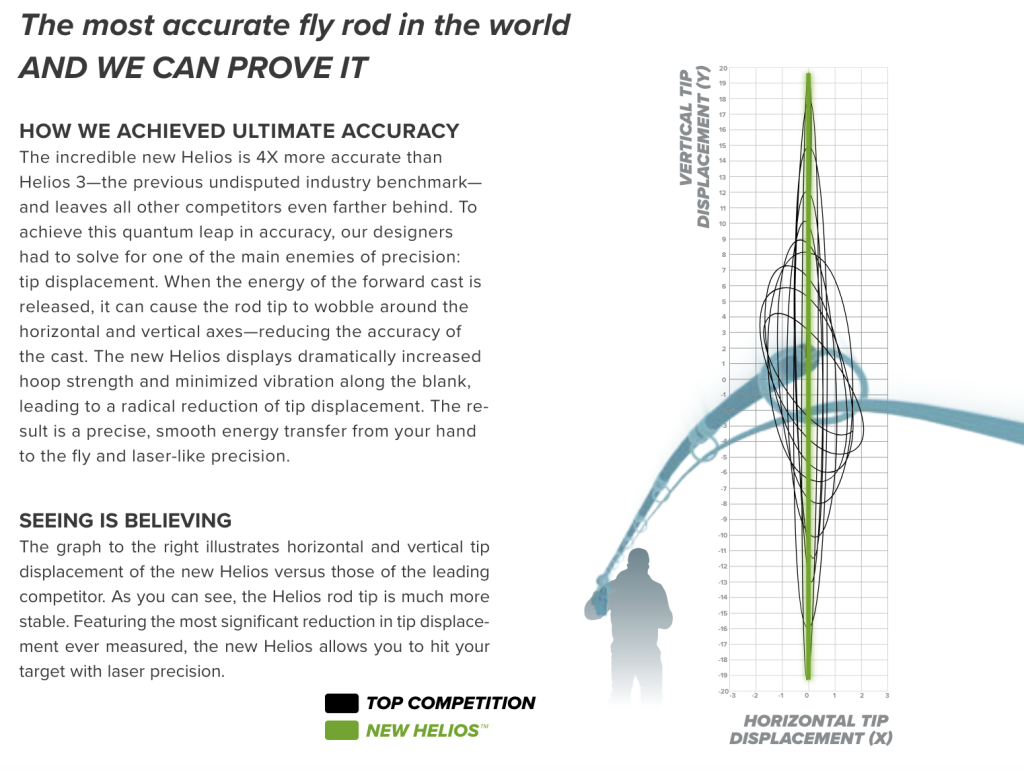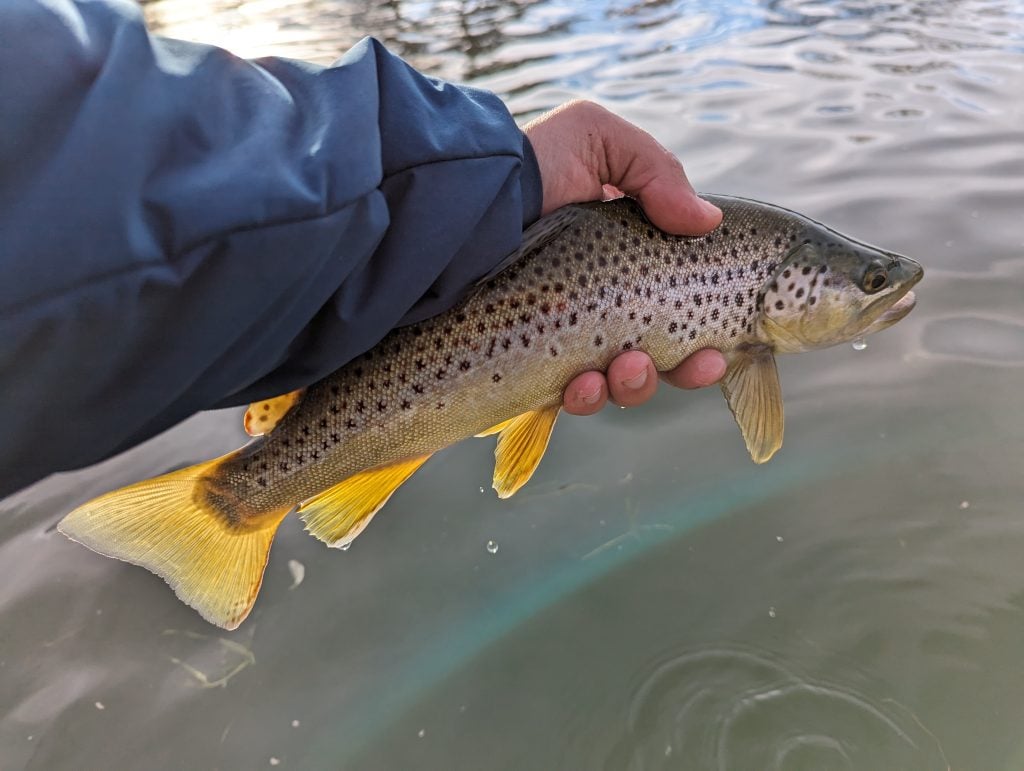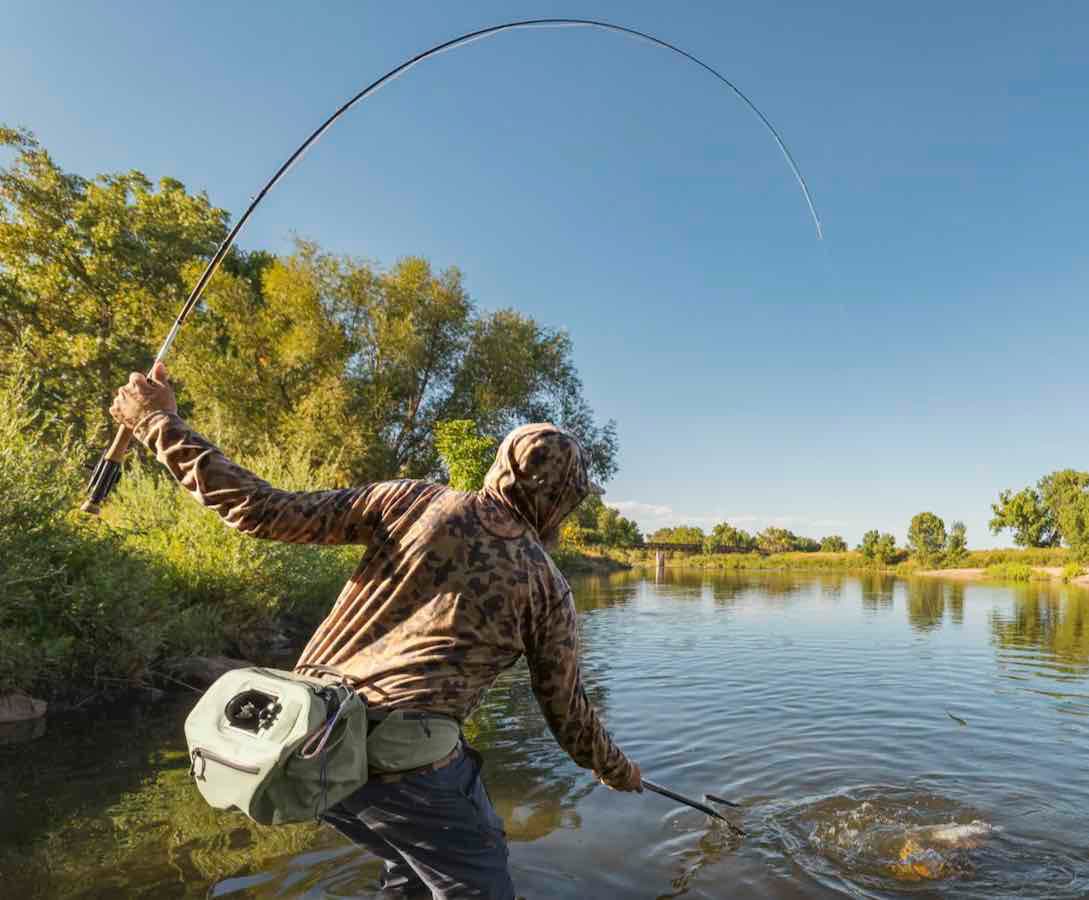Gear Review: Orvis Helios Fly Rod
By now you’ve seen the social media posts, web banners, and videos telling you that the latest and greatest rod from Orvis is “four times more accurate” than their previous flagship, the H3. It’s supposedly 25% stronger, more enjoyable to cast, and will only run anglers $100 more than the now-discontinued H3 lineup.
The new rod – simply called the Helios, not the H4 – is supposedly improvement on what, to me, felt like the pinnacle of Orvis’ fly rod design philosophy. Back in 2019 I said that I thought the H3 would gain the cult-like following the Sage XP enjoys, and based on a cursory glance at comments around the release of the new Helios, I think I’m right. The H3 earned that adoration because it’s an excellent rod with a wonderful balance of power and finesse, and at the time, it was at the forefront of the technological advancements that create more accurate fly rods. Hence the famous marketing campaign from Orvis, “Accurate from Anywhere.”
So, why am I spending so much time at the start of a review on the new Helios talking about its predecessor?
Because I didn’t know if Orvis could top the experience I had when fishing with an H3.
Each rod manufacturer, whether they admit it or not, has a certain expectation to live up to from the angling public. We expect Winstons to be excellent dry fly rods, a Sage should be a powerful, but refined stick, and an Orvis—thanks largely to the H3—should provide an accurate, easy casting experience.
I’m not going to put one of these flagship rods above another because they’re all different enough that comparing them is pointless; they’re also all great enough that it’s like splitting hairs to pick a “best one.”
I will say, however, that the new Helios is the best Orvis rod I’ve ever fished. It delivers on what I expect an Orvis rod to be, and I see it as an honest improvement over the H3.
Orvis hasn’t ever paid me, and they’re not paying for this review. I’m not making a dime on whether you choose to buy the Helios. I’m telling you, angler to angler, that the new Helios really does live up to its marketing hype.
Let’s take an in-depth look at why.
Accuracy
Orvis’ claims that the Helios is four times more accurate than the H3 has the ring of marketing speak. After all, isn’t accuracy largely on the shoulders of the angler?
Yes, but there are certain elements of the fly rod that designers can tweak to make the rod inherently more accurate. Chief among them is how well the rod “tracks” during a cast. Tracking refers to the path that the rod tip travels during a casting stroke. In an ideal world, the rod tip would stay in a completely straight line. In reality, rod tips move both horizontally and vertically. If you were to look at a fly rod’s tip from a bird’s-eye view during a cast, you’d see the tip traveling in a slight oval.
Rods that track well have tips that travel in as little of an oval as possible. A rod that tracks well is inherently more accurate, because that side-to-side movement of the rod tip can throw a wrench in where your fly line, and ultimately your fly, ends up.
As you can see from the below piece of marketing collateral from Orvis, the Helios tracks exceptionally well.

This isn’t just some made-up graphic from an intern, either. The team at Orvis developed their own method to measure how well the new Helios tracks.
“We used a high-speed infrared camera that picks up reflected light,” Shawn Combs, Orvis Director of Product Development, said. “We put a reflector on the tip of the fly rod, and the camera picked up only the tip of the fly rod.”
What they found was that the Helios tracks left and right a grand total of 0.4 inches, or less than the width of a tip-top guide. The outgoing H3 tracked left and right a total of 1.6 inches. That’s real, quantifiable improvement over what was one of the most accurate fly rods I’ve ever fished.
Does this actually matter, though? Will an angler notice a difference while on the water?
I certainly did.
My review model was the 9′ 5-weight D (just like the H3, the Helios is available in both “Distance” and “Finesse” variations, with a total of 29 different models available), and I had no problems laying down laser-accurate casts during a blue-winged olive hatch. I’m not a great caster, but I felt like one while using the Helios. During that hatch, I wanted to see how far I could push the Helios and still maintain great accuracy, so I was fishing from greater distances than I normally do. I had no problems landing my size 16 parachute BWO right in front of a trout at 60 feet. The fish was even kind enough to eat my fly on the first drift.

Photo: Spencer Durrant
The Helios maintained that accuracy with heavier rigs, as well. While throwing a crawdad-egg nymph combo with an indicator, I was able to get my flies in the right lines and drifts on the first or second cast.
During my chat with Combs, he told me he felt like the Helios simplifies the more demanding fly casts—big rigs, reach casts, aerial mends, and the like. I wholeheartedly agree.
Again, accuracy largely lies on the angler. But the Helios eliminates so many variables in the accuracy department that I think any angler will notice a difference. I’d love to see some of my fishing buddies, who are far better casters than I am, with the Helios in their hands.
Strength and Power
Another claim from Orvis is that the Helios is 25% stronger than the H3. That’s a fairly easy claim to measure – bend the fly rod until it breaks. Take a look at just how much of a bend the folks at Orvis put into the Helios:
View this post on Instagram
Strength isn’t just about how far you can bend a rod until it breaks, though. As Combs told me, “It’s not about how much bend you can put in a rod before it blows up, it’s about the amount of reserve power and backbone in the butt section.”
That reserve power will give anglers more control over the fight—in both fresh and salt water—which means that fish will be released in a less-fatigued state.
It’s hard to quantify this on the water, but I felt like I had more than enough control over the trout I caught on the Helios. I had the fortune of hooking into a few pretty nice fish—including one rainbow that went almost 20 inches— and I never felt underpowered. In fact, I hooked and landed that almost 20-inch rainbow in rough water, on a deep nymph rig, within two minutes. I’d normally expect that fight to take longer, based on the size of fish and strength of the current, but I exerted considerable pressure on the trout and got it in quickly.
I think the added lifting power will be especially noticeable in the bigger-game versions of the Helios, but trout anglers will notice a difference. The biggest difference everyone will notice, though, is just how smooth the Helios is.
This is a result of the design process, which began with a full teardown of the H3. From that teardown, Combs told me that he and his team were able to assess potential failure points within the H3 blank, as well as areas of the blank where stress could be concentrated during a cast or while fighting a fish. In reality, those spots can feel like hinges to anglers. The Helios is built to transfer power as smoothly as possible throughout the blank, resulting in a rod that doesn’t concentrate stress in any particular spot. That smooth transfer of energy is also partly responsible for the increased strength of the Helios.
The last item to note here is the low swing weight. This is another performance aspect that’s hard to measure, but it refers to how “heavy” a fly rod feels during a cast. Rods with low swing weights concentrate most of the mass of the blank closer to the handle, which makes the rod feel lighter during the cast. The swing weight on the Helios is so low that, on my first lawn casting session, I was worried I wouldn’t feel the line load and unload. I did, of course, but the fact I worried about that speaks to how light in-hand the Helios feels. This isn’t a rod that’ll wear you out after a day of fishing.
Build Quality
The Helios picks up where the H3 left off in terms of aesthetics and build quality. The white sticker is still in place above the cork, but it’s more subtle this time around.
In lighter-weight models, Orvis went back to using a wood insert in the reel seat. I prefer wood inserts in reel seats, especially for trout-focused rods. It does nothing for the performance, but I like my gear to look nice, and real wood looks better than anodized aluminum, in my opinion.

The cork is top-notch, and the modified full wells grip on some of the Helios models has a new taper to it that I like. It naturally pushes my hand a bit further back on the grip, which is the grip I prefer.
After ditching a hook keep a few years ago on all their rods, Orvis opted not to include one on the Helios.
“The primary reason behind removal of the hook keeper was to help the angler rig between spots faster,” said Combs. “A secondary benefit by not having a hook keeper is that the angler can hook their fly to the stripping guide, wrap the line around the reel foot and keep the leader to line loop to loop connection out of the tip top.”
I’ve never been a fan of this design choice, and I’m still not. I understand what Combs is saying about keeping the loop-to-loop connection out of the tip-top certainly makes for a smoother spot-to-spot transition while fishing. But I’ve lost count of how many times I reach to place my fly on the hook keep, only to realize it’s not there, even after years of owning three different H3 models. It’s a personal preference, but I wish Orvis kept the hook keep.
This isn’t a dealbreaker. It doesn’t impact the rod’s performance at all. But it’s worth mentioning.
Final Verdict
Alright, let’s discuss the elephant in the room—the price. At $1,098, the Helios isn’t an attainable rod for many anglers. For most of us, it’s hard to justify spending that kind of cash on a fly rod.
However, I don’t feel it’s an unreasonable price. The H3 was $998, and with how inflation has hammered everything lately, I was surprised to see the price of the Helios only rise $100.
I know I’m on record in other reviews lamenting the high cost of flagship fly rods these days. But it’s always been this expensive to own the best rods, if you do a little digging.
A look through a Winston catalog from 1975 shows their flagship bamboo rod (the finest rod they made at the time – this was before graphite) cost $275. Adjusted for inflation, that same rod would run you $1,557.49 in 2024 dollars. In 2013, a Sage One retailed for $775, which is $1,013.68 in 2024 money.
So, we’re paying roughly the same for top-tier fly rods that we always have, even if the actual dollar cost is higher. Now, whether a fly rod is worth $1,098 is entirely up to an individual, but remember this before you blast Orvis for rolling out a rod that costs about the same as my mortgage: Orvis invested a serious amount of R&D into the Helios. Between rod prototypes, field testing, developing new systems to measure tracking, salaries for all the folks involved, marketing, and materials costs, it’s not a surprise that Orvis’ best rod will set you back a significant amount of money.
I’m not trying to defend Orvis, and I’m certainly not trying to defend the high cost of a flagship rod. I’m just trying to contextualize the cost.
In the end, the Helios is among the best fly rods I’ve ever used. If you want the best, you often have to pay up for it.
From a performance standpoint, I have nothing to nitpick. The Helios is a pleasure to fish. It’s fun, it’s accurate, it’s light, and I experienced more than a few moments that had me thinking wow, did I really just make that cast? As I mentioned at the outset of this review, I wasn’t sure if Orvis could top the experience I had when fishing the H3, but they did.
And that’s what so hard about reviewing fly rods—communicating how it feels to use a certain rod, because we all interpret things a bit differently. What I can say is that I felt unstoppably accurate and confident with the Helios. I enjoyed every moment I spent with the rod, which isn’t true for every rod I review. I love how smooth the rod feels, how it never felt like I was asking too much of it, and how it responded to my mistakes.
I’ll moan about the lack of a hook keep for the rest of my days, but that’s not a dealbreaker. Orvis knocked it out of the park with the Helios, and if you ever get the chance to fish (or own) one, I’d highly recommend it.












